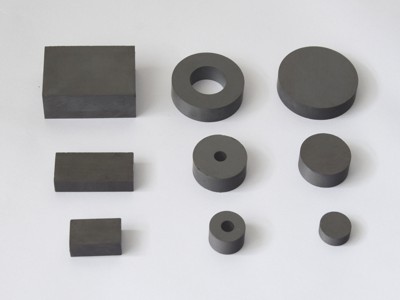Ferrites
Introduction
Ferrite magnets are the most widespread group of magnets. Their global consumption reaches annually approx. 300 000 tonnes and continues to rise.
Their quality and the product range have been continually advancing. Their advantage is the least expensive cost per kilogramme and a great variety of dimensions and shapes.
Alongside permanent magnets, magnetically soft ferrites are also used in technical practice as the cores of coils, transformers and limiting chokes (More at www.ferity.cz).
Properties
Ferrites are, chemically, oxides of iron and barium or strontium, which after sintering have the nature of a ceramic material. Their striking features are hardness and brittleness. This requires caution when handling magnetised products in the vicinity of other magnets and ferromagnetic materials.
The magnets are manufactured in standard shapes which can be slightly modified by grinding. However, care needs to be taken to ensure the ground surface does not become hot (see the table of magnetic properties - max. application temperature).
Applications
Ferrite magnets have a wide range of applications. They are used as retaining magnets in industrial, office and household design.
They are placed in small electric motors and generators, they are part of magnetic clutches and brakes. They are used in the manufacture of toys, they serve as position and rotation sensors, as switches, etc.
Magnetické vlastnosti - ferity
| Class | Coercivity | Remanence | Max. product | Curie temperature |
| HcB [kA/m] | Br [mT] | (BH)max [kJ/m3] | oC | |
| Y10T | 128-160 | >200 | 6.4-9.6 | 450 |
| Y20 | 128-192 | 320-380 | 18.36-21.5 | 450 |
| Y25 | 135-170 | 360-390 | 22.5-28.0 | 450 |
| Y30 | 175-210 | 380-400 | 26.0-30.0 | 450 |
| Y30BH | 230-275 | 380-400 | 27.0-32.5 | 450 |
| Y35 | 160-190 | 400-420 | 30.0-33.5 | 450 |


